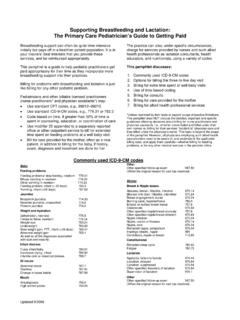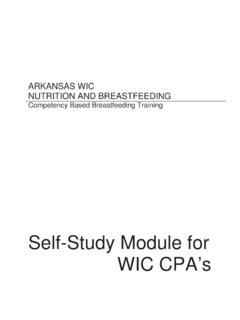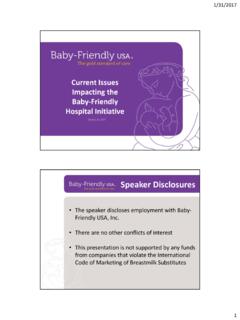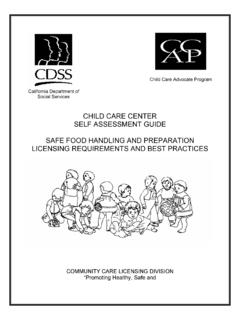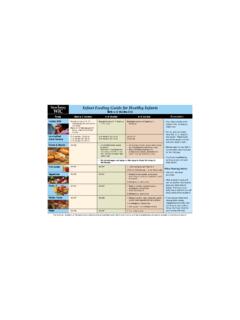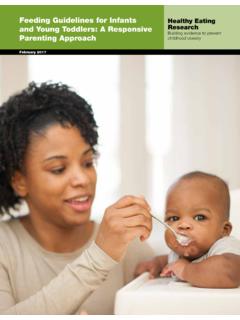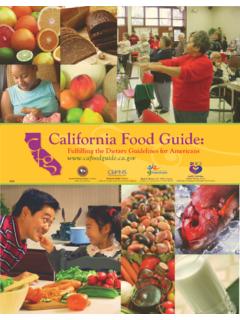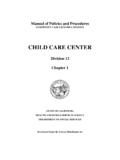Transcription of California Infant Feeding Guide 2016 - calwic.org
1 California Infant Feeding Guide 2016 Presented by the California Breastfeeding Coalition And the California WIC Association in partnership With California Department of Public HealthRyan Gamba, , Professor in Health SciencesCSU East Bay Objectives Identify what the Infant Feeding Guide is and where to find it Describe the changes that have been made in the newest version of the Infant Feeding Guide State three examples of Feeding recommendations based on developmental stagePollTo what extent have you read the new California Infant Feeding Guide ?A)I have read part of itB)I have read it cover to coverC)I have not read any of it (it is on my reading list) California Infant Feeding Guide 2016 Document Library/ here through the California Department of Public Health:Purpose of the Infant Feeding Guide Purpose: Provide evidence based up to date recommendations for Feeding healthy infants from 0 1 year of age Target Audience.
2 Health Care & Public Health ProfessionalsBreastfeeding remains the optimal food for human infantsNew & Exciting ResearchUpdated ContraindicationsAlcohol & BreastfeedingMarijuana & BreastfeedingHealthy People 2020 ObjectivesPollHow many racial/ethnic groups are meeting the Healthy People 2020 Objectives for breastfeeding initiation? Human Milk is the Preferred Substitute for BreastmilkIndications for the Use of Banked Human Milk or Commercial Infant FormulaThe need for long-term supplementation of the breastfed baby is rare as most infants who are allowed to self-regulate their feedings will thrive on human milk and their mothers will be able to maintain an adequate milk supply.
3 Before recommending supplementation, both mother and Infant should be evaluated by a healthcare professional. GMO s? Prebiotics? Fatty Acid Fortification? Commercial Infant formula made without genetically modified organisms:No studies were identified on the health benefits of non-genetically modified organism commercial Infant formula. Commercial Infant formula with prebiotics: Not enough evidence is available to determine if there are positive health effects associated with the use of probiotic and/or prebiotic-supplemented commercial Infant , 45, 46 Commercial Infant formula with fatty acid supplementation: Studies in non-human species suggest supplementing the diets of newborns with docosahexaenoic acid (DHA) and arachidonic acid (ARA) may lead to positive these results have not been replicated in is insufficient evidence for a statement for or against fatty acid supplementation of commercial Infant formula at this Water for FormulaCronobacterInfectionsBaby Cues when Bottle FeedingINTRODUCING COMPLEMENTARY FOODSPollThe adequate intakes of what 2 nutrients have changed in this newest version of the California Infant Feeding Guide ?
4 And and and Vitamin B12 and FolateBreastfeeding in the First week of LifeTable 5: Feeding Recommendations for Caregivers of Healthy Full-Term Infants According to Developmental Stage and Nutrient Needs1, 52, 66, 72-75 Developmental Stage Approximate Age Feeding Recommendations to Meet Nutrient Needs Rooting reflex will gradually diminish Sucks and swallows liquidsMay push food out with tongue Birth to six months What to feed? Exclusive breastfeeding until six months of age. Prior to six months, Infant digestive tract may not be mature. If not breastfeeding or offering banked human milk, use iron-fortified commercial Infant formula. No complementary foods at this time.
5 No other fluids such as tea, juice, vitamin waters or other adult beverages. Water may be recommended by a physician in some medically necessary to feed? Feed when the Infant shows early signs of hunger. Signs of hunger can vary by child but often include the baby holding their hands near the mouth, sucking noises and puckering of the lips. Note that crying is a late sign of hunger. Watch for Infant s cues of satiety. Provide pauses during the Feeding so that the baby can communicate with cues the desire to continue Feeding or to stop. Cues of satiety often include a slowing or stoppage of a baby s sucking, relaxation of the hands and arms, or turning or pushing away from the nipple.
6 Breastfeed on-demand at least 10 times or more in 24 hours. There is no maximum Stage Approximate Age Feeding Recommendations to Meet Nutrient Needs Sits with support Holds head steady Keeps food in mouth and swallows it Six months What to feed? Continue to breastfeed or provide banked human milk or iron-fortified commercial Infant formula on demand. Breastmilk or commercial Infant formula is still the primary source of nutrients. Introduce complementary foods. Watch for signs of allergic reactions that could include hives, rash, coughing or wheezing. Plain iron-fortified Infant cereal can be mixed with breastmilk or commercial Infant formula.
7 Sugar, honey, soy sauce or salt does not need to be added. While fish is ok,DO NOT feed large predatory fish, such as shark and swordfish because these large fish can accumulate heavy metals in their to feed? A new complementary food can be introduced 3 days after the last new food. Start with single-ingredient foods. The order of foods is not critical, although high-iron foods are recommended first such as pureed meat and iron-fortified cereals. Feed with a spoon. The Infant should be sitting upright and supervised. Feed 2-3 small meals per day, with snacks optional. Start using a cupfor expressed breastmilk or formula. A strainer, blender or baby food grinder can be used to make baby food.
8 Meat, chicken, eggs or cooked beans can be strained or pureed; tofu can be mashed. Cooked vegetables and soft fruits may be offered strained or pureed. DO NOT put cereal or other foods in the bottle. DO NOT force feed or extend Feeding time beyond a half hour. DO NOT feed too much complementary foods, for instance no more than one half cup of complementary food at a sitting. Table 5: Feeding Recommendations for Caregivers of Healthy Full-Term Infants According to Developmental Stage and Nutrient Needs1, 52, 66, 72-75 Table 5: Feeding Recommendations for Caregivers of Healthy Full-Term Infants According to Developmental Stage and Nutrient Needs1, 52, 66, 72-75 Developmental Stage Approximate Age Feeding Recommendations to Meet Nutrient Needs Grasps and holds onto things Sits with ease and without support Begins to chew Uses a cup with help May self-feed finger foods.
9 7 to 8 months What to feed? Continue to breastfeed or provide banked human milk or iron-fortified commercial Infant formula by cup. Offer a variety of foods pureed with lumps; gradually progress to mashed foods. Sugar, honey, soy sauce or salt does not need to be to feed? Provide 3-4 meals per day with 1-2 snacks. Begin meals with the family. Encourage and explore self- Feeding by providing soft, easy to swallow finger foods cut in small pieces. Self- Feeding is also an important opportunity for mastery of fine motor skills. Avoid foods in a form that may cause choking ( , items that have a shape and/or consistency that may cause them to become lodged in the trachea, such as whole nuts, whole grapes, and pieces of hot dog, popcorn, and raw vegetables, whole or in pieces).
10 DO NOTforce feed or extend Feeding time beyond a half hour. Note: Satiety cues at this ageinclude changes in posture, closing mouth tightly, distractibility, playing with or throwing utensils, and more active hands. DO NOT leave child alone during Feeding . Developmental Stage Approximate Age Feeding Recommendations to Meet Nutrient Needs Takes a bite of food Self feeds finger foods Uses a cup without help or with minimal help 8 to 10 months What to feed? Continue to breastfeed or provide banked human milk or iron-fortified commercial Infant formula by cup. Offer chopped soft cooked foods. Continue to offer a variety of new foods. Finger foods such as soft cheese, unsalted crackers or small pieces of tortilla, tofu or toasted breads.



